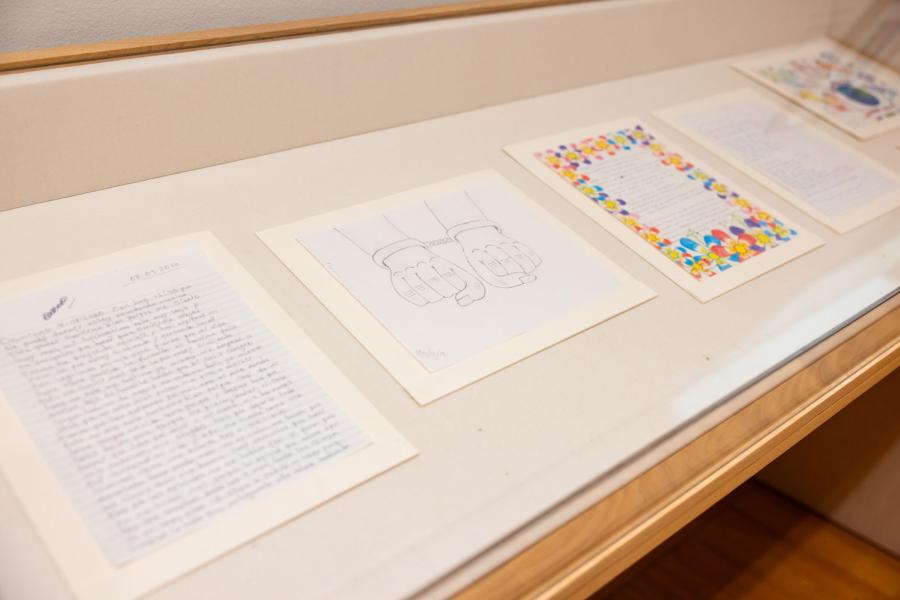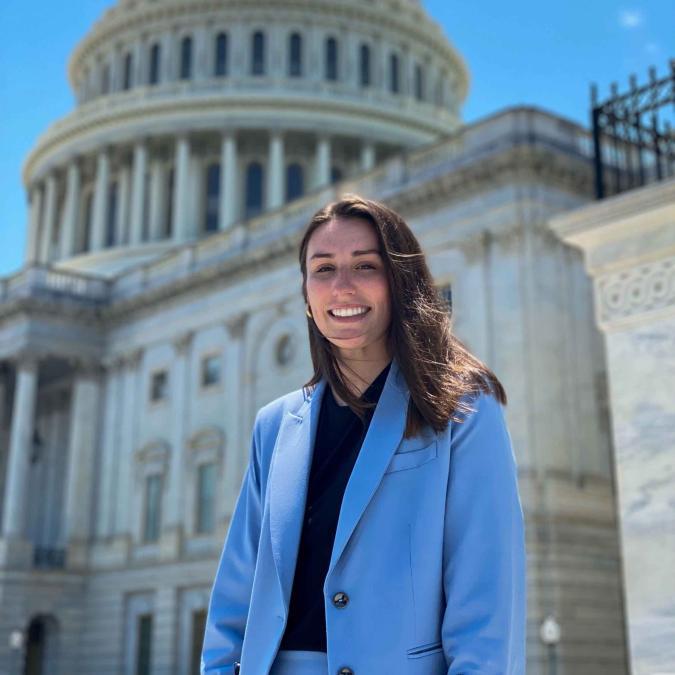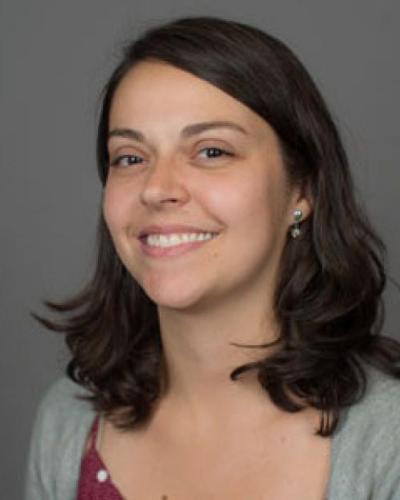At Cornell’s Johnson Museum of Art, the work of renowned artist Guadalupe Maravilla is on display in the same space as that of Ingrid Hernandez-Franco, a Salvadoran woman whose asylum case was championed by a Cornell professor and her students.
Their common themes? Migration, activism and healing.
The exhibit, “Guadalupe Maravilla: Armonía de la Esfera” (Harmony of the Sphere) opened in January and will run through June 9. During its development, Maravilla visited campus twice and met with Franco, students in the Cornell Anti-Detention Alliance (CADA) and their advisor, Jane Juffer, professor of literatures in English and feminist, gender and sexuality studies in the College of Arts and Sciences. These meetings inspired new directions for the exhibition, which includes letters that Franco wrote to Juffer during the more than two years she was detained at the Buffalo Federal Detention Center in Batavia, N.Y., as well as artwork Franco did during that time.
Franco also contributed to a game of lines called Tripa Chuca, which Maravilla includes with all of his at exhibitions and which adorns three of the museum's massive walls. (Sharifa “Elja” Sharifi, an artist who fled Afghanistan in 2021 and became a visiting scholar at the Johnson Museum, also played the game, so her work is also evident here.)
“Guadalupe’s work is very multifaceted,” said Rodrigo Guzman-Serrano, a doctoral student in history of art, who co-curated the show with Jessica Levin Martinez, the Richard J. Schwartz Director of the Johnson Museum. “He engages with ideas of healing, sound and sculpture, also pre-Hispanic objects, indigenous art and immigration, popular culture, urban Hip-Hop.”
During Maravilla’s visits to campus, members of CADA told him about exhttps://museum.cornell.edu/event/a-coiled-serpent-archaeological-and-artistic-perspectives-on-pre-hispanic-art/periences working with immigrants also detained for undue periods of time, such as Franco. While advocating for the abolition of detention, CADA documents injustices of those detained, writes letters and visits people in Batavia. During her stay thee, Franco experienced homophobia and racism in addition to the injustice of being imprisoned for seeking refuge in the U.S., Juffer said. Maravilla’s work connects to these experiences and other forms of trauma that immigrants to the U.S. encounter, she said. One of his talks during an earlier visit is available to see here.
Sebastian Young ’25 was able to join Maravilla and Martinez for dinner during one of his visits to campus.
“To have the opportunity to get insight from Guadalupe on his migration story, as well as brainstorm how CADA could help with outreach for the exhibit, was great,” Young said.
Maravilla will be visiting the museum again in late April to offer several small sonic experiences, which are already full, but he will also join a symposium at the Museum on April 30: “A Coiled Serpent: Archaeological and Artistic Perspectives on Pre-Hispanic Art,” from 9:30 a.m. to 12:45 p.m. The event includes two panel discussions, one with anthropology professor John S. Henderson (A&S) and graduate students Rafael Cruz Gil and Andrea Mauri (anthropology), and a second with Guzman-Serrano in conversation with Maravilla, Ananda Cohen-Aponte (associate professor in the Department of History of Art & Visual Studies in A&S), and artist Emilio Rojas (visiting critic, Department of Art). More information is available on the museum’s website.
As part of the Johnson exhibition, Maravilla also selected a number of pre-Hispanic objects from the Johnson Museum’s permanent collection and Cornell’s Anthropology Collections. These pieces highlight continuities in movement, transit and exchange across the Americas.
Guzman-Serrano said Maravilla’s work is very autobiographical, focusing on his own journey to the U.S. from El Salvador as an unaccompanied child at the age of 8. So, Maravilla connected with Franco and her story. Franco fled El Salvador due to persecution based on her sexual orientation; she recently was granted political asylum.
“Maravilla not only confronts his own trauma but also invites us to consider the potential for renewal and healing inherent in embracing one’s past,” Guzman-Serrano wrote in the notes for the exhibition.
Maravilla has presented solo exhibitions at the Museum of Modern Art; the Brooklyn Museum; the Museum of Contemporary Art Denver; Henie Onstad Kunstsenter; Socrates Sculpture Park; the Institute of Contemporary Art, Miami; the Institute of Contemporary Art, Boston; and elsewhere.
This is the second in a series of exhibitions and programs at the Johnson Museum developed in conjunction with the Migrations Global Grand Challenge, part of Global Cornell, with support from the Andrew W. Mellon Foundation’s Just Futures Initiative. The museum also worked with Frederic W. Gleach, curator of the Anthropology Collections (A&S), and Leonardo Santamaría-Montero, also a doctoral student in the history of art, who provided research and writing on the pre-Hispanic works on view.








